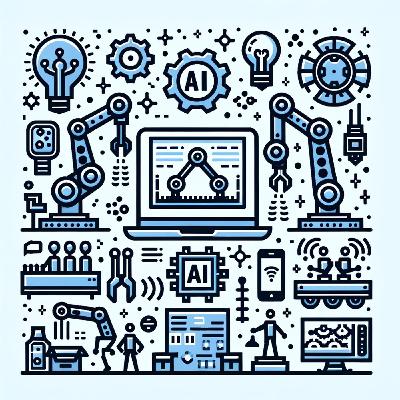Robots Rocking the Factory Floor: AI, Cobots, and the Automation Revolution!
Update: 2025-10-03
Description
This is you Industrial Robotics Weekly: Manufacturing & AI Updates podcast.
The world of industrial robotics enters October 4, 2025, at an inflection point, where breakthroughs in automation, artificial intelligence, and workforce collaboration are rapidly reshaping manufacturing and warehouse environments. Recent reports from the International Federation of Robotics reveal that the global market value for industrial robot installations has soared to an all-time high of 16.5 billion US dollars, reflecting a surge in demand as companies race to mitigate labor shortages, optimize processes, and future-proof production lines. Faster learning cycles are becoming possible through artificial intelligence: analytical and physical AI models now allow robots to adapt on the fly, run simulations virtually, and facilitate seamless, small-batch production or rapid retooling to meet shifting market demands, as covered by Evertiq and Gray Matter Robotics.
Smart factories are going mainstream in 2025, powered by machine learning and the industrial internet of things, with nearly nine out of ten manufacturers planning to integrate AI into production networks, according to Hanwha. Real-time sensors, cloud-connected machinery, and digital twins enable predictive maintenance, drastically reduce equipment downtime, and catch product defects in milliseconds. The result is accelerating productivity and far greater throughput—especially in sectors like automotive, electronics, and aerospace—while minimizing energy use, waste, and overall costs. Collaborative robots, or cobots, are now central to safety and teamwork on the factory floor. European innovators such as Neura Robotics and Franka Emika, as detailed by Standard Bots, are leading the charge in adaptive cobots equipped with next-generation safety and control systems, allowing humans and robots to work side by side with fewer barriers and unprecedented efficiency.
Several notable deployments hit headlines this week: Rapid Robotics in the United States announced a new pay-as-you-go robotics service for food manufacturing, reducing automation costs for small businesses. In China, government-backed Siasun and EFORT launched lightweight mobile arms aimed at speeding warehouse picking, and Universal Robots celebrated the milestone of over fifty thousand cobots installed worldwide, now handling tasks from quality inspection to logistics. A fundamental trend underpinning all of this is the move toward flexible, scalable automation, enabling tailored solutions for heavy payload assembly in metal and aerospace, precise PCB handling in electronics, and fully autonomous vehicles for warehouse material transport.
Practical takeaways for manufacturers include investing in AI-enabled monitoring to maximize uptime, considering cobot deployments for ergonomically challenging or repetitive tasks to support worker safety, and recalculating total cost of ownership to account for reduced maintenance, increased efficiency, and the availability of robotics-as-a-service options. Looking forward, the evolution will be characterized by greater autonomy, deeper human-robot synergy, and a shift to green, data-driven manufacturing models.
Thank you for tuning in to Industrial Robotics Weekly. Join us next week for more insights at the frontier of automation and AI. This has been a Quiet Please production. For more, check out Quiet Please Dot A I.
For more http://www.quietplease.ai
Get the best deals https://amzn.to/3ODvOta
This content was created in partnership and with the help of Artificial Intelligence AI
The world of industrial robotics enters October 4, 2025, at an inflection point, where breakthroughs in automation, artificial intelligence, and workforce collaboration are rapidly reshaping manufacturing and warehouse environments. Recent reports from the International Federation of Robotics reveal that the global market value for industrial robot installations has soared to an all-time high of 16.5 billion US dollars, reflecting a surge in demand as companies race to mitigate labor shortages, optimize processes, and future-proof production lines. Faster learning cycles are becoming possible through artificial intelligence: analytical and physical AI models now allow robots to adapt on the fly, run simulations virtually, and facilitate seamless, small-batch production or rapid retooling to meet shifting market demands, as covered by Evertiq and Gray Matter Robotics.
Smart factories are going mainstream in 2025, powered by machine learning and the industrial internet of things, with nearly nine out of ten manufacturers planning to integrate AI into production networks, according to Hanwha. Real-time sensors, cloud-connected machinery, and digital twins enable predictive maintenance, drastically reduce equipment downtime, and catch product defects in milliseconds. The result is accelerating productivity and far greater throughput—especially in sectors like automotive, electronics, and aerospace—while minimizing energy use, waste, and overall costs. Collaborative robots, or cobots, are now central to safety and teamwork on the factory floor. European innovators such as Neura Robotics and Franka Emika, as detailed by Standard Bots, are leading the charge in adaptive cobots equipped with next-generation safety and control systems, allowing humans and robots to work side by side with fewer barriers and unprecedented efficiency.
Several notable deployments hit headlines this week: Rapid Robotics in the United States announced a new pay-as-you-go robotics service for food manufacturing, reducing automation costs for small businesses. In China, government-backed Siasun and EFORT launched lightweight mobile arms aimed at speeding warehouse picking, and Universal Robots celebrated the milestone of over fifty thousand cobots installed worldwide, now handling tasks from quality inspection to logistics. A fundamental trend underpinning all of this is the move toward flexible, scalable automation, enabling tailored solutions for heavy payload assembly in metal and aerospace, precise PCB handling in electronics, and fully autonomous vehicles for warehouse material transport.
Practical takeaways for manufacturers include investing in AI-enabled monitoring to maximize uptime, considering cobot deployments for ergonomically challenging or repetitive tasks to support worker safety, and recalculating total cost of ownership to account for reduced maintenance, increased efficiency, and the availability of robotics-as-a-service options. Looking forward, the evolution will be characterized by greater autonomy, deeper human-robot synergy, and a shift to green, data-driven manufacturing models.
Thank you for tuning in to Industrial Robotics Weekly. Join us next week for more insights at the frontier of automation and AI. This has been a Quiet Please production. For more, check out Quiet Please Dot A I.
For more http://www.quietplease.ai
Get the best deals https://amzn.to/3ODvOta
This content was created in partnership and with the help of Artificial Intelligence AI
Comments
In Channel





